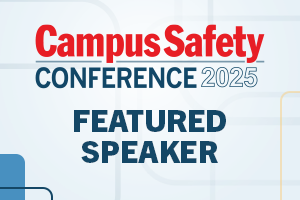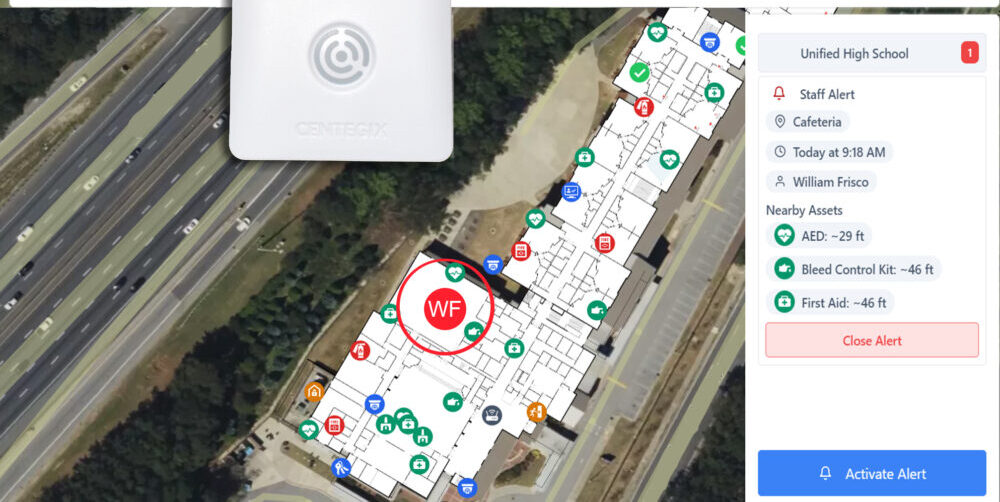- WGTC provides panic buttons to campus employees so they can summon help during an emergency
- This case study outlines how the police department vetted various products and chose CENTEGIX as its vendor
- Chief James Perry provides tips on how to maximize the effectiveness of panic alarm systems
“HELP ME!” No two words have so much meaning when someone, maybe even you, needs help due to a medical crisis or an assault.
How do we communicate that message, especially if we are alone, have no phone or are in an area with no cell service? A long list of other issues could also influence this situation.

WGTC Chief of Police James Perry will be presenting “A Multi-Layered Approach to Campus Safety: Integrating Technology, Collaboration, and Response Lessons from West Georgia Technical College” at this summer’s Campus Safety Conference being held in Austin, Texas, July 21-23. For more information and to register, CLICK HERE.
A few years ago, West Georgia Technical College (WGTC) was faced with these questions as well as how to send mass notifications to everyone. After much trial and error resulting in no good, reliable solution — especially considering budget constraints–we discovered CENTEGIX’s personal panic buttons.
WGTC Spoke with Other Campuses About Their Emergency Communications Technologies
In doing some research, we came across other campuses using the system and visited one such school for a demonstration and Q&A with the school system employees. CENTEGIX’s personnel were not aware at this point that WGTC was looking at their system. We preferred to hear the real-life results from actual users and not get a sales pitch. What we got was a solid referral from the school personnel and an actual demonstration by them.
Upon return, our team contacted CENTEGIX and was immediately impressed with the honest conversation and the customer care demonstrated by them. That customer service has not wavered over the years and is, in fact, one of the most impressive selling points about the company.
The decision to implement CENTEGIX panic buttons was made fairly quickly, and as soon as funding was secured, their installation team went to work. They worked throughout the night to avoid disruption of classes and moved from one campus to another.
Will the Panic Buttons Signals Go Through?
West Georgia Tech operates in seven different counties in Georgia with most considered rural. Cell phone service on several campuses is challenging and, at times, almost non-existent. There are many buildings and large open spaces associated with WGTC. One of the buildings is a World War II bomb manufacturing facility with a lead-lined roof. You can only imagine the cell phone signal issues in this building. We were very impressed with the ability of CENTEGIX to read and send the alert signal in less than three seconds, on average, in all buildings, including the World War II-era building.
Related Article: New Campus Emergency Communications Survey Highlights Advances in Mass Notification and Panic Alarm Systems
Since the installation of the panic buttons, we have had numerous alerts for medical issues, and with an officer on campus, their response to the scene in many cases was less than one minute.
We kept our notification system simple: three clicks of the badge means, “I need help.”
CENTEGIX Solution Helps Officers Quickly Locate Victims
When a panic button is pushed by an employee, all campus police officers, regardless of their assigned campus, receive the alert. A quick glance at their cell phone tells them who pushed the alert button and their location. Locations inside buildings are signaled by room number, hallway or another known identifier. Outside, the location is identified by reference to the campus layout — specifically how WE wanted it named. The phone also shows a map of the campus and identifies the location of the activated badge.
In a recent active shooter exercise, we had two role players activate their badges at the same time. One remained in the same location, and the other moved to another location. The campus officers were able to identify both role players and their individual locations… even the moving “victim” was tracked as their location changed throughout the building. This is another great feature of CENTEGIX.
Again, keeping things simple, our system is set up for a second type of alert, activated by eight clicks of the button. This places the campus on lockdown and indicates a serious threat. It should be noted that we have had lockdown alerts that were not real due to people panicking during serious medical conditions. They didn’t count the number of times they pressed the panic button. We don’t mind this as we can be on scene quickly and cancel any further response if not needed.
How Does the Panic Button Work?
In one medical emergency, I observed a person walking by the campus police office and heard them breathing heavily. I immediately thought they really didn’t need to be there. A moment later, a CENTEGIX panic alarm was activated. One glance at my phone told me it was the employee I had just witnessed walking by with labored breathing.

West Georgia Technical College Chief of Police James Perry. Photo courtesy WGTC
The display showed her exact location, and I ran down the hall, arriving in seconds. The person had fallen and was trapped under her desk. As she fell, she struck something that broke some of her ribs. She was in extreme pain and had even more difficulty breathing.
Related Article: Will Alyssa’s Law Become Federal Legislation?
I radioed campus dispatch to get medical in route and began trying to comfort her. This person immediately told me if she had not been wearing her CENTEGIX badge, she was not sure how long she would have laid there before being found. A regular desk telephone was above her, but there was no way she could have reached it. Given her injury and distance from others, I’m not sure she could have even yelled loud enough for anyone to hear her.
This is but one of many examples of successful uses we have had with this solution. Due to the installation features and mapping of the buildings, it has a proven track record. We have had employees tell us, “It really works.”
Training and Demonstrations Can Help Overcome Resistance to New Technology
Success stories in no way mean we didn’t meet some push back with initial implementation of the panic buttons. We had a few employees who claimed we were tracking and spying on them. One resistant employee searched Google and told us how he thought we could track him. However, after years of use, we still can’t do what he alleged. This problem often exists with anything new; some people will be against it.
For us, we found that educating our employees, doing demonstrations with the system and having real-life users share their experiences eased the conspiracy fears and helped prove how valuable the solution is.
I highly suggest policy development and implementation with mandatory wearing of the badge. Once staff get used to it, they become less likely to leave it in their car or at home. In addition, teach proper care of the badge. In our case, we place the badge behind the employee identification card, which is also expected to be worn at all times while they are on campus.
Related Article: How Wearable Technology Keeps Hospitals and Schools Safer
We orient the badge and “help” button according to the person’s primary hand and teach them how to access the button without letting others know they have done so. This can be very important when dealing with an irate and possibly violent customer or student. When used in this manner, we have had officers arrive at the location and be standing beside the irate person without them realizing help was summoned. This surprise has in some cases de-escalated the situation immediately.
We still have an occasional call for help by phone. Upon arrival and after dealing with the situation the officer often asks, “Why didn’t you use CENTEGIX?” The response is typically, “I forgot.” Again, training is critically important, and with employee turnover, it needs to be done often.
WGTC Police Department Led Implementation
Implementation of the panic button solution was conducted by our police department at an in-service training event. It was a long day but went well with controlling the device’s issuance; and since then, monitoring and replacing badges as needed.
The officers are the only ones who receive the alerts. For us, this process works well. Our procedure allows the officer on the campus that’s affected to begin an immediate response. The other officers act as force multipliers. Since we can view cameras on every campus from any of our offices, another officer can communicate what he might be seeing and advise the responding officer. In the case of a violent situation, this information can be critically useful.
I have worked with other institutions using CENTEGIX and other alert systems. I have seen some that have up to seven different alerts. However, at WGTC, we choose to keep it simple. We want people to use it, and we don’t want them to hesitate or get confused by the number of clicks. It is more important that we respond quickly and then determine the actual need for service.
Upon my arrival at WGTC, an in-house phone alert system was in use. Once I was trained to use the old system and I reviewed the list of codes, I located the person who was most comfortable using it and asked them to do a test alert for me. Running a stopwatch, I found that even with their best effort, it took 27 to 29 seconds just to go through the prompts and activate the system. This was completely unacceptable and changes were initiated immediately, getting the old system’s response time down to around 15 seconds.
However, understanding that every second matters, I still was not satisfied. CENTEGIX with its two- to three-second alert time was a significant improvement.
Challenges with the New Panic Alarm System Are Minor
There are a few negatives to the new panic buttons. The brightness of the strobes has been improved recently; however, it can still be an issue outside in bright sunlight. CENTEGIX did improve them recently, but we still find they are not bright enough outside, or in some other cases, to draw the attention of those nearby.
Our desire to have it integrate with our cameras will hopefully be forthcoming. In specific areas, an added siren would be beneficial.
I’m sure as I write this, CENTEGIX has some new features they are working on, and I look forward to seeing what they are.
I do not recommend many products or services. They must be used and proven by me for that to happen. With CENTEGIX, it has been used numerous times for real life emergencies on our campuses and has proven to be a solid tool for us.
I am continually impressed by their customer service and response time if I need assistance. Typically, I get a same-day response, or in the case of late-day needs, it might be the next day. Seldom does any company offer that type of experience and service. I fear a large company purchasing CENTEGIX, and should that happen, I would be amazed if they could maintain the same level of customer service.
No system works for everyone, but I truly believe CENTEGIX might be close. We faced hurdles that other panic alarm systems could not overcome. We have tested CENTEGIX in many conditions and different circumstances, and it has proven successful every time.
For a few who have it and have reached out to me with operational issues, I have found that the root cause of the problems was improper or infrequent training causing a low level of confidence with the technology. In these cases, I have not found the fault to be with CENTEGIX but with the end user. Take advantage of the training offered and then play with it, test it and retest it to get comfortable. It might just very well be the system that works for you.
Finally, I watched a recent video of a terrible incident on a campus. My immediate thought was, “I wonder if the victim had been wearing a CENTEGIX badge, would the outcome have been different?”
James Perry is in his tenth year of serving as chief of police for West Georgia Technical College. He previously worked as an EMT and then served with the Carrollton Police Department and Georgia Bureau of Investigation.
NOTE: The views expressed by guest bloggers and contributors are those of the authors and do not necessarily represent the views of, and should not be attributed to, Campus Safety.







